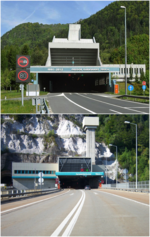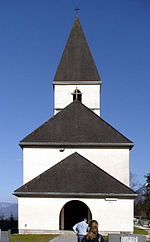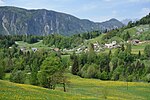Karawanks Tunnel (railway)

The Karawanks Tunnel (German: Karawankentunnel, Slovene: Predor Karavanke) is the fourth longest railway tunnel in Austria and the longest in Slovenia with a length of 7,976 metres (26,168 ft) (4.96 miles). It passes under Rožca Saddle between Rosenbach in southern Austria and Jesenice in northern Slovenia. Upon opening in October 1906, the Karawanks Tunnel formed an important element of the Karawanken Railway, which was - together with the Bohinj Railway - constructed to connect the port of Trieste with Klagenfurt, the capital of the federal state of Carinthia in Austria. Despite the dissolution of the Austro-Hungarian Empire, which had been a driving force for its construction, the line and tunnel alike continued to be a well-trafficked route largely used by freight trains travelling between Austria and Slovenia. During the twenty-first century, the Karawanks Tunnel underwent extensive modernisation, being rationalised from a twin-track layout to a single track to comply with modern safety standards.
Excerpt from the Wikipedia article Karawanks Tunnel (railway) (License: CC BY-SA 3.0, Authors, Images).Karawanks Tunnel (railway)
Graschenitzengraben, St. Jakob im Rosental
Geographical coordinates (GPS) Address Nearby Places Show on map
Geographical coordinates (GPS)
| Latitude | Longitude |
|---|---|
| N 46.521 ° | E 14.026 ° |
Address
Graschenitzengraben
Graschenitzengraben
9183 St. Jakob im Rosental
Carinthia, Austria
Open on Google Maps









